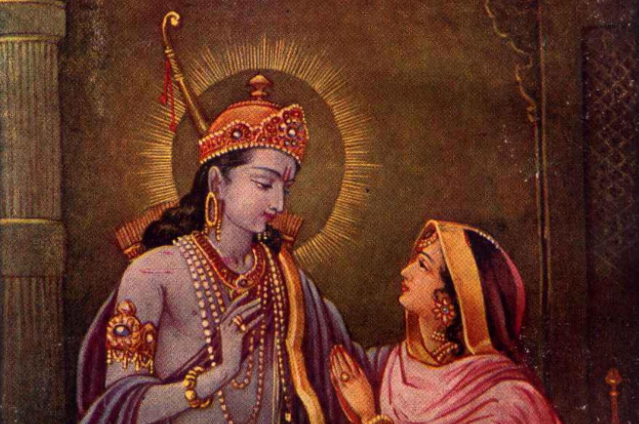
The representation of iconic female characters in Indian mythology has seen drastic changes. Be it Sita, Draupadi, Mandodari, or Ahalya—each character has her own representation and fixed motive. There are five central female characters who are regarded highly because of their virtues, upheld through vivid obstacles.
Sita is one of the most important characters from the Ramayana. Her abduction by the demon king Ravana compelled the war to take place, and the epic heroic custom followed—the slaying of the dragon by the medieval hero, and the demon Ravana by a force that is part of the divine. Rama, the incarnation of Lord Vishnu, fulfilled his duty of destroying evil.
Sita’s depiction in the supposedly original version of the epic is that of a brave Kshatriya woman—a queen. Her disapproval of Rama for testing her chastity merely because of his subjects’ doubt in her character shows her sense of justice and self-respect. When a man and a woman who are married stay away from each other for a long period of time, both should be considered when the question of chastity arises.
For a long span of time, the honor of the household has been associated with the women of the household. Even in the twenty-first century, a daughter gets murdered brutally by her own father because of her decision to be independent, which supposedly ends up tainting her family’s honor and chastity. Fueled further by colonialist approaches, the ideology kept becoming more socially normalized. Sita’s depiction in modern books is quite interesting to observe.
1. The Forest of Enchantments
Chitra Banerjee Divakaruni’s The Forest of Enchantments, written and published in 2019, revisits the Ramayana epic but from Sita’s perspective. Divakaruni’s narrative effectively captures the social boundaries expected of women. Sita’s expression of being discriminated against in Ayodhya reflects a strong female agency. Her opinion of Dasharatha separating things for her in comparison to his son shows how brave and honest she is.
Divakaruni’s previous work also reflects Draupadi’s inner strength and composure. Sita and Draupadi are both characters from the canon of Indian mythology. Sita’s final emergence into the lap of Mother Earth—far away from Ayodhya—is her ultimate power moves
2. Sitayana
As the title suggests, Sitayana narrates the story of Sita. Just like Ramayana refers to the tale of Rama, the divine prince of Ayodhya, the term yana refers to a way of narrating someone’s story.
Amit Majmudar’s effective storytelling presents a new perspective. However, this perspective is not entirely new. Way back in the 14th century in Bengal, a female poet named Chandrabati wrote her own version of the epic. The focus on the epic war of the Ramayana is reduced to something of minor importance. The epic also introduces an antagonist character named Kukuya, Kaikeyi’s daughter.
Kaikeyi and her daughter are described as women who are intrinsically evil. Their inherent wickedness shines through even at the time of Kukuya’s birth—the cows moo loudly, and the sky breaks into dark clouds, foreshadowing the disastrous events to follow.
3. Sita – Devdutt Pattanaik
Devdutt Pattanaik is well known for his mythological books. His presentation of Sita in this book closely follows Valmiki’s original portrayal—a fierce warrior princess. Her fiery personality and strength are tested during her first fire trial.
Equated with Draupadi, who was considered pure as she was born of fire, Sita walks not only through the fire but also through the metaphorical boundaries imposed by society. In the Bengali version of the epic by Krittibas, Lakshman draws a line which he forbids Sita from crossing under any circumstances. This line—Lakshman Rekha—represents the social boundaries expected of women, lines set by society that should not be crossed.
While the narrative does depict Sita’s helplessness, it does not do so to weaken her character—internally or externally. Her surprise at being abandoned for the third time, especially while she is pregnant, is heartbreaking and deeply emotional.
These three books provide a strong foundation for interpreting Sita through a modern lens. The long-standing idea that women should be as submissive and docile as Sita has evolved into a more nuanced understanding of her as a symbol of strength—showing that the transformation has moved in both directions. There are several more books on this perspective, however.
Sita by Devdutt Pattanaik
The illustrations in the book enhance the storytelling and narrative. The story includes an assimilation of strong, independent female characters.
In Chandrabati’s Ramayana, Sata is considered to be Sita’s second mother. Sita has three mothers in the text—the earth goddess Bhumi Devi, Sata (a common fisherwoman), and Queen Sunaina, wife of King Janaka.
After being blessed with a beautiful daughter as an act of divine goodwill, the royal couple named the child after Sata, as mentioned earlier. The drastic shift in the perception of Sita proves how time continues to change literary interpretations.
